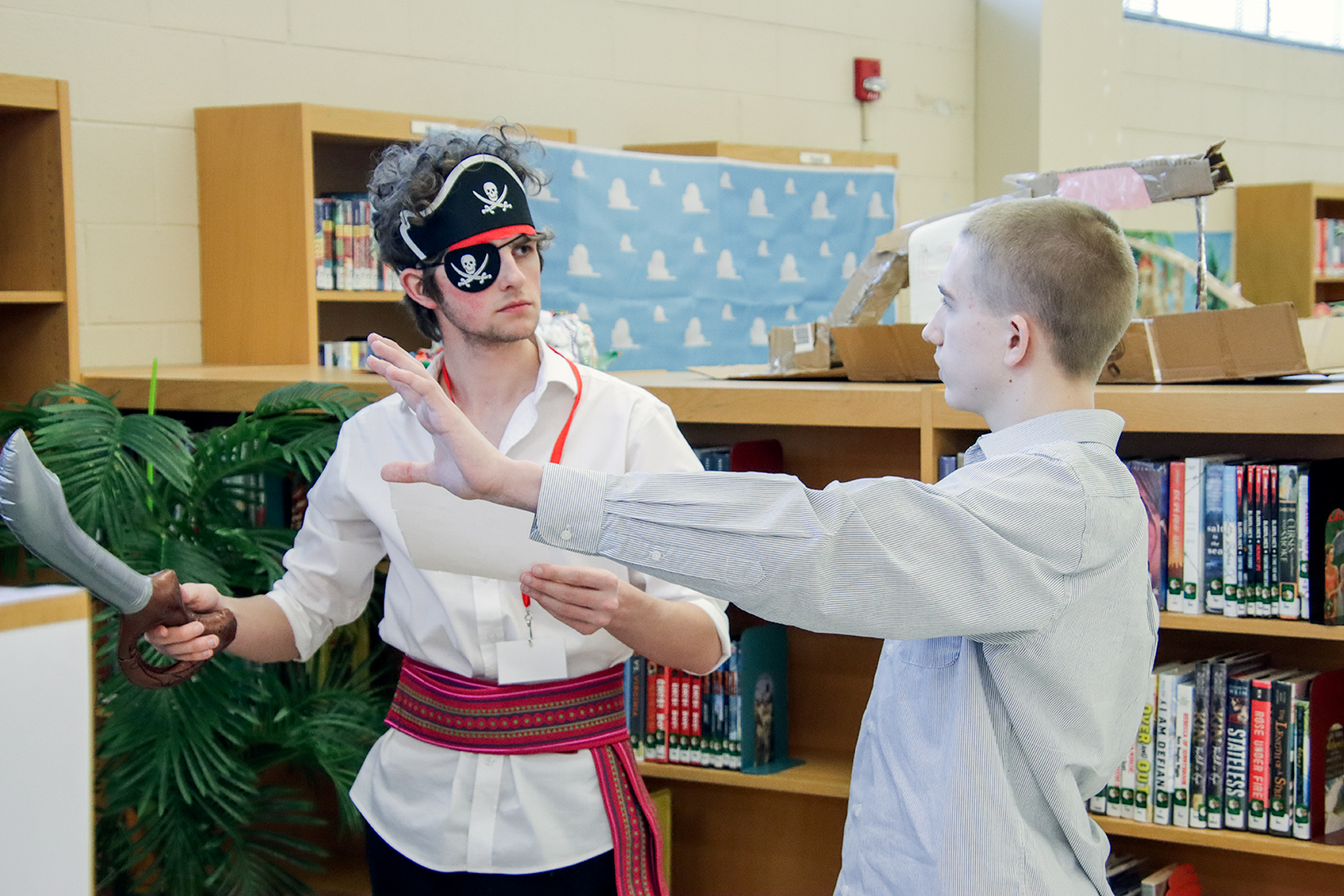
Agriculture teacher Coye Elliott, left, looks over poinsettias with seniors Drew Rodgers and Ruth Wooten at Lone Oak High School (McCracken County) Jan. 7, 2011. They sold 600 poinsettias during the holidays and saved some to grow into much larger plants for next year. Photo by Amy Wallot
By Matthew Tungate
matthew.tungate@education.ky.gov
Where others saw 5 acres of concrete, Coye Elliott saw agriculture.
Four years ago, Elliott agreed to take over an agriculture program with 48 students at an urban school where 90 percent of students lived in subdivisions and four percent lived on farms.
“The only grass we had on campus was in the greenhouse,” said Elliott, Lone Oak High School (McCracken County) agriculture teacher and FFA adviser.
And then he delivered his mantra: “Agriculture and FFA are not just about farming.”
Elliott now has a robust program, with 428 of the 900 students in the school taking at least one agriculture class from Elliott or his two colleagues: second-year teacher Brittany Brammeier and first-year teacher O.P. McCubbins.
Matt Chaliff, state FFA executive secretary and Kentucky Department of Education agriculture consultant, said Lone Oak’s program is one of the most progressive and fastest-growing in the state. With classes like Greenhouse, Animal Science, Contemporary Issues in Agriculture, Agriscience, Sports Turf Management and Agriculture Construction, teachers are working hard to make agriculture relevant to non-farm students, he said.
“The teachers have focused on innovative and relevant instruction,” Chaliff said. “They have made a consistent effort to ensure that students are able to apply what they learn in careers and in life. The integration of FFA, the co-curricular student organization for agriculture students, and work-based learning has helped students develop critical-thinking and problem-solving skills, which are so important in a 21st-century environment.”
Nontraditional agriculture education
Elliott, the son of two (non-agriculture) teachers, said he has emphasized non-farm topics, such as veterinary for small animals like cats and dogs, and horticulture such as sports turf technology because his students can relate to them better than cows, pigs and tobacco fields.
Or, as McCubbins says, “This isn’t just about cows, sows and plows.”
“Although we sit on 5 acres, we’re not limiting our learning to those 5 acres. Knowing that in the state of Kentucky agriculture is a predominant field, we didn’t want to limit our students to the 5 acres that we sit on.”
Principal Brian Harper, Lone Oak High School (McCracken County)
McCubbins was planning to stay in college to work on his master’s degree when he saw that Lone Oak High was looking for a third agriculture teacher. He had to apply, he said, because it reminded him of when he was a student at Nelson County High School.
He was a four-year member of FFA, which is his only experience with agriculture “other than mowing grass.”
But traditional agriculture and farming were not emphasized at his high school, and he knew the benefits he had received from belonging to FFA.
“I think it’s a great thing because we don’t have a lot of kids in this school who are from traditional farming backgrounds,” he said. “They don’t look at it like they are involved in ag.”
But having pets, mowing grass, eating food and purchasing clothes are all agriculture, McCubbins said.
“We try to open their minds to the different connections to agriculture outside of traditional farming,” he said
He, Elliott and Brammeier offer a challenging curriculum, work-based learning, project-based learning and research-based learning, as well as teacher-led instruction. Plus, they give students a lot of room for creativity.
“We let them explore, in their own world, different and various activities in agriculture,” McCubbins said.
Brammeier started the animal science career pathway last year as a part-time teacher, and she has already seen the program grow from 25 students to 125.
She said she has emphasized working with small animals because students can relate to them. The school has started a rabbit-breeding program, which Brammeier said helps teach the students responsibility, as they are responsible for feeding, cleaning and taking care of the rabbits.
“With that breeding program, they’re learning without knowing they’re learning,” she said. “It’s learning through doing, so that makes it easier for them to learn.”
Third-year Principal Brian Harper was a teacher at Lone Oak High for seven years before leaving and coming back. He said he and the previous principal wanted to expand the agriculture program to provide students with more opportunities.
“Although we sit on 5 acres, we’re not limiting our learning to those 5 acres,” Harper said. “Knowing that in the state of Kentucky agriculture is a predominant field, we didn’t want to limit our students to the 5 acres that we sit on.”
FFA a key component
He said some of the school’s most dependable students are agriculture students and members of FFA. Harper knows the students take pride in the school.
“They don’t want that stigma of ‘We’re just a bunch of farmers.’ They really don’t want that label,” he said. “They want to see that they’re leaders within the school.”
Elliott said he initially went to college wanting to be a basketball coach like his father and thought his love of agriculture would be the best way to get a job.
Now he is too busy with FFA to coach, as the organization gives students a way to compete in something other than sports
“FFA is not just about farming anymore,” Elliott said. “It is about farming, it’s not JUST about farming.”
Brammeier is the only one of the three to grow up on a traditional farm – 1,500 acres in southern Illinois with cows, horses and pigs.
“Animals were what brought in the money and paid the bills, and that’s where I learned a lot of the things I know,” she said.
But it was her school’s FFA that helped her find her place in high school. Now, as a teacher, Brammeier sees students having the same connection and relates to them.
“I understand that you don’t have to be a basketball or football all-star to be worth something at this high school, and the FFA gives them that ability to be individuals,” she said.
But FFA isn’t about just belonging or even winning awards in contests, for which FFA may be best known.
Brammeier said that what students learn in class relates to FFA competitions, which relate to expectations in college and careers. Because of that, students want to be in agriculture classes and administrators recognize that, she said.
“You can’t go wrong when the kids say, ‘Oh, the bell’s about to ring,’ and they want to stay,” Brammeier said.
MORE INFO …
Coye Elliott, coye.elliott@mccracken.kyschools.us, (270) 538-4150












Congratulations LOHS Ag Teachers and Students! What a great article! Lone Oak Middle is proud of you!
As with all of our graduates, the Murray State University Hutson School of Agriculture faculty and staff are proud of these three teachers who are all alumni of our program. We are proud of the impact that they are having in their school, their community and upon their students.
Tony Brannon, Dean
Hutson School of Agriculture